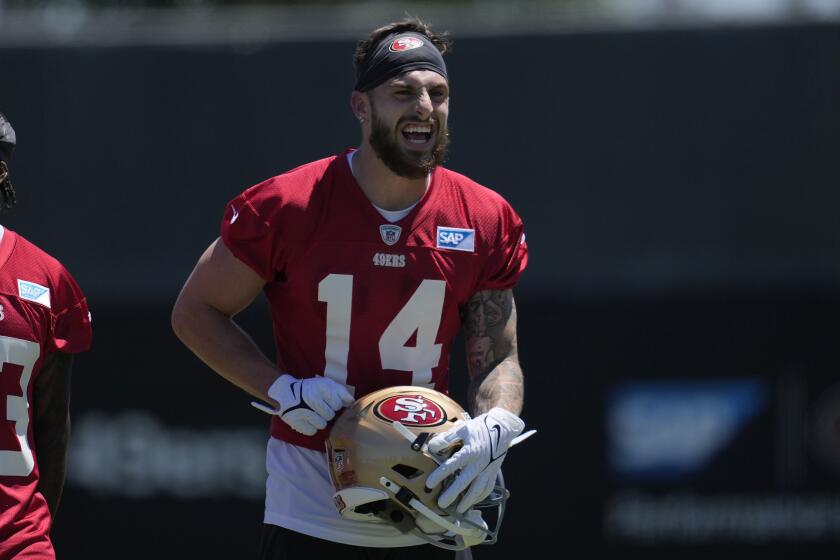Hey, Take Your Time, It’s Only a Ballgame : Baseball: Three hours is just about the average these days and television isn’t the only one to blame.
Runners at the corners. Tying run at the plate. Two outs, bottom of the ninth. Lefty tugs at his cap. He wipes his brow. Now he’s back on the rubber--looks for the sign, shakes one off. Oh, he steps off. There’s gonna be a conference now. Oh-oh. Here comes the Skipper now, too. He’s looking toward the bullpen. He’s not motioning yet. . . . They’re gonna talk about it. Now the umpire is coming out to break it up. Skip’s gonna leave him in there! No, wait! He’s motioning to the bullpen. He wants the right-hander. . . . Finally, here’s the windup and the pitch:
Baseball games are infested with these time-consuming habits, these irritating stoppages, these tedious moments that seem to wring every last second out of an inning, like drops of water out of a wet dishrag. The National Pastime is becoming the National Past-bedtime.
In short, baseball games are too long.
Take the fictional scenario above. It’s loosely based on actual events that commonly occur in a typical game--in this case, the first inning of a Toronto Blue Jays-New York Yankees night game played June 3. The count was 1-and-1. The Yankees had runners on first and second with one out. Kevin Maas was at the plate facing left-hander Jimmy Key. It went like this: Key tugged at his cap three times. Maas stepped out of the batter’s box. Maas took three practice swings. Maas stepped back in. Key checked the runners. Key wound up and threw. Maas popped a foul ball into the seats. Key rubbed up a new ball. Key paced around the mound. Key threw another pitch. Maas popped another foul into the seats. Two pitches later, Maas struck out swinging.
The at-bat consumed six pitches. The ball was never put in play. The sequence took five minutes.
“Some of these games are ridiculous,” said Ralph Kiner, the New York Mets’ broadcaster and Hall of Fame slugger. “And I don’t think it’s getting better. I think it’s getting worse.”
In fact, the time of an average game in the American League rose from 2:36 to 2:51 in a 10-year span, 1980-90; in the National League, the increase was from 2:32 to 2:45. Since 1985, the time of an average ballgame has dipped only once from the year before. And although the leagues have no figures available for this season, we do.
April 9--Mets 2, Phillies 1. Three runs scored. Elapsed time--3:25.
April 11--Phillies 8, Mets 7 (yes, them again). In 10 innings. Would have set the record for the longest nine-inning game in major-league history--at 4:25--had it not gone into extra innings. Elapsed time--4:51.
April 15 -- White Sox 6, Yankees 5. Four Chicago pitchers are required to pitch a five-hitter. Elapsed time--3:42.
May 15 -- Red Sox 9, White Sox 6. Sets the record for the longest nine-inning night game. Elapsed time--4:11.
June 2--Padres 3, Astros 1. Four runs scored. Seven hits. Six pitchers. Elapsed time--2:54.
There are a variety of factors contributing to the creeping length of games, from the obsessive use of relief pitchers to longer TV timeouts to an increasing number of pickoff attempts to the shrinking strike zone to the idiosyncracies of Carlton Fisk, who adjusts shinguards, polishes baseballs, calls summit conferences with the infielders, talks to the dugout and landscapes the catcher’s box.
But this much is certain: From 1980-90, the average of a Seattle Mariners’ game jumped from 2:25 to 2:49; the Yankees went from 2:32 at home to 2:53; the Mets increased from 2:35 at home to 2:48; the Philadelphia Phillies grew from 2:26 to 2:46. It’s fashionable for yuppie essayists to praise baseball’s “unhurried pace,” its “pastoral beauty,” but we know what they really mean. The game is slow.
“There are so many little things,” said broadcaster Tony Kubek, the former Yankee. “Like, every time a guy gets to second base now, the catcher comes out to the mound for a conference. Guys have been getting to second base for a hundred years. It doesn’t always require a conference.”
Kubek has a statistical report on his ’61 Yankees. Out of curiosity, he checked Whitey Ford’s first six starts. None, said Kubek, was longer than 2:06. But Kubek figured, hey, Ford worked fast and Ford threw strikes, so he looked up Bob Turley, who could be a little wild, just to be fair. And out of Turley’s first six starts, the longest lasted 2:30.
In the 1930 World Series between the St. Louis Cardinals and the Philadelphia Athletics, none of the six games lasted longer than 1:58, according to research conducted by the St. Louis Post-Dispatch. But in the 1987 Series between the Cardinals and the Minnesota Twins, none of the seven games was played in under 2:39. Like Kiner said, it’s getting worse.
“We played a team recently and they had back-to-back starters who were painfully slow,” said Yankee pitcher Scott Sanderson, no rabbit himself. “It was frustrating. We were all talking about it on the bench. But it’s not the pitchers most of the time. I think it’s the hitters.”
“I think it’s the pitchers,” Kubek said.
“It’s the umpires,” Kiner said.
There’s enough blame to go around. Take TV, please. Joel Nixon, the NHL’s vice president for broadcasting, was the executive producer of Mets telecasts in the early ‘60s, when the TV break was one minute between half-innings.
“And I can tell you, it was very well-enforced,” Nixon said. “The umpires would move the game along. I remember when Mr. Bob Gibson pitched we were always worried because he’d run out to the mound and throw seven warmup pitches in the time it took anybody else to throw two and he’d be ready to go. And we’d still be in a commercial.”
But now the TV breaks are two minutes each half-inning. For games broadcast on ESPN, the break can stretch to 2:15; for CBS games, to 2:25. That alone accounts for a possible increase of up to 18 minutes, or more, each game. Still, fingering TV alone is like blaming Madonna for the sexual revolution: It already had started, she just helped out.
There’s the pitching, which ranges these days from bad to abominable. How else could Bud Black command a four-year, $10-million contract? But under today’s standards, Black looks like Cy Young.
The use of relief pitchers is at an all-time high (the Yankees, for instance, had two complete games through June 1, and used at least five pitchers in a game nine times). At their current pace, AL pitchers will issue 8,293 walks, a large hike over the 1987 record of 7,812.
Then there’s the growing use of relief specialists. Years ago, you had a relief ace such as Luis Arroyo or Hoyt Wilhelm who’d pitch three innings sometimes. Now you have the set-up man and the closer. You have left-handers brought in to pitch only to left-handed hitters, and managers with quick hooks.
“We’ve had--what?--five managers fired already this year,” Kubek said. “Managers worry about their jobs and they wind up blowing out their bullpens because they’re worried about the immediate and not how tired the pitchers are going to be in August. You can’t blame them.”
In a game against the Mariners, Stump Merrill lifted Tim Leary after he allowed only one run in 8 1/3 innings and brought in Greg Cadaret. He went 3-and-0 on Greg Briley before Merrill ordered him intentionally walked. Then Merrill yanked Cadaret.
The Mets are no better, their average time of 2:50 last season ranking longest in the NL, and it’s not just Mackey Sasser’s tap-tapping, either. Remember the controversy stirred when Bud Harrelson signaled David Cone to pitch out, and Cone chose not to? It turns out that in 1989 there were almost as many pitch-outs (6,856) as stolen-base attempts (7,086), says STATS, Inc., in its book “Baseball Scoreboard.”
The runner was actually going about 7% of the time. The California Angels called 144 pitchouts. And caught nobody.
The return of base-stealing also has forced pitchers to keep runners closer to first base, which means more pickoff throws, which means more time spent on nothing. In a game against the Athletics this season, White Sox starter Charlie Hough threw to first base 40 times. Last year, Hough led the major leagues with 368 throws to first base.
“There is so much time taken by the pitchers,” Kiner said. “I was a teammate of Early Wynn, and he was slow. I hated playing behind him. But he was a lot faster than these guys.”
On the other hand, Kiner said, “The batters step out too much. Hey, Ted Williams never stepped out of the box. What’d he hit?” You get the point.
Will it change? Not as long as TV revenues skyrocket and the networks pack in as many commercials as they can; not as long as batters scratch and relief pitchers parade in from the bullpen, one after the other, and baserunners dust off their pants. So baseball just goes merrily along, tugging at its cap, shaking off the sign, stepping off the rubber.
More to Read
Go beyond the scoreboard
Get the latest on L.A.'s teams in the daily Sports Report newsletter.
You may occasionally receive promotional content from the Los Angeles Times.






